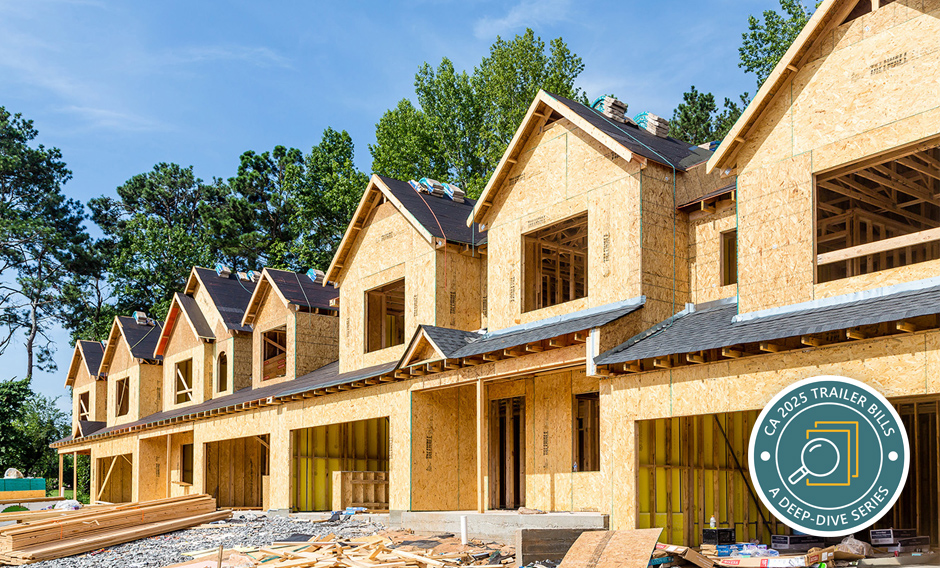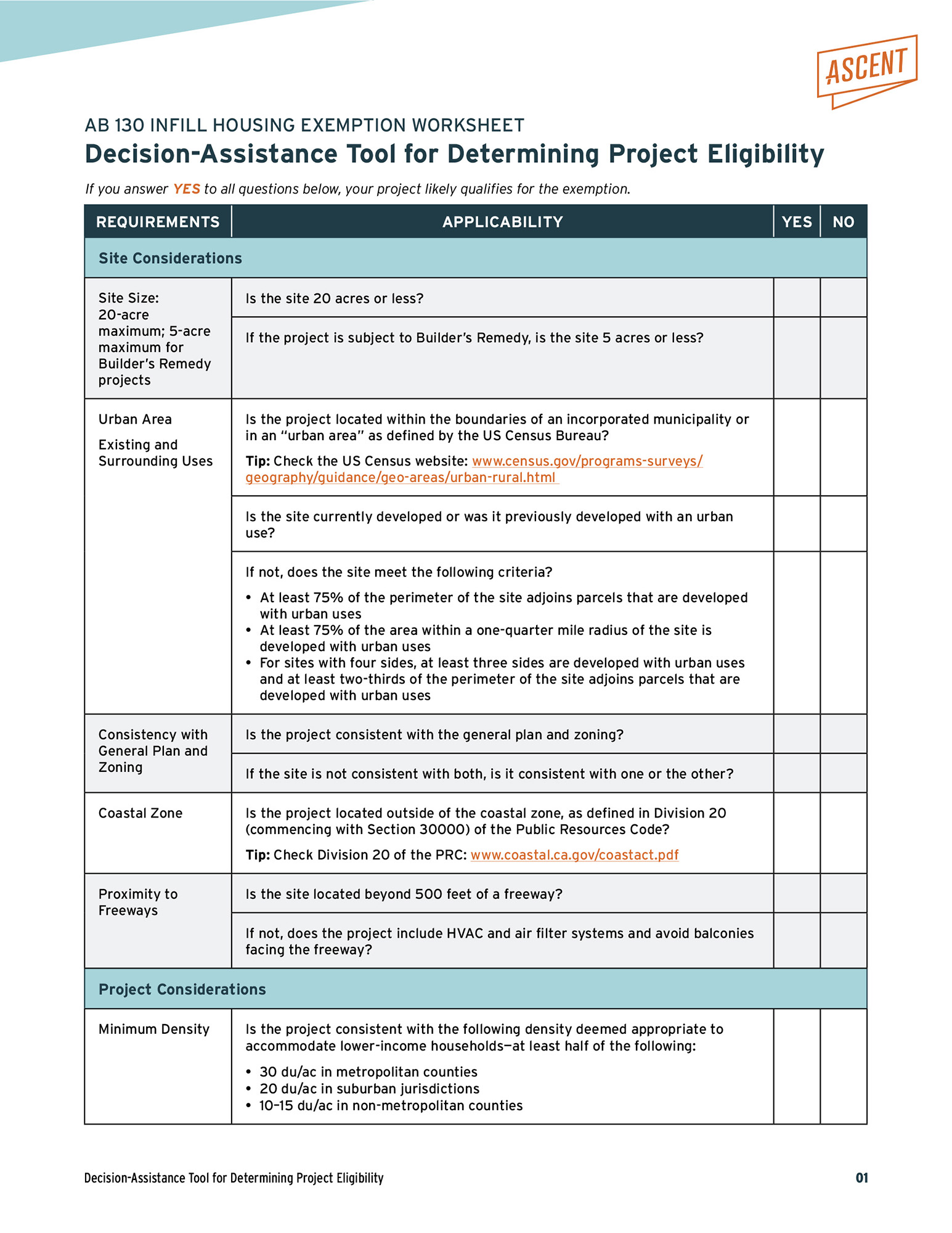AB 130: An Introduction
While the California Environmental Quality Act has played an important role in informing local governments and communities about the environmental effects of development proposals, it also has been criticized for causing substantial delays and increased costs of urban housing projects and providing a pathway for project opponents to block development through challenges and litigation, thus contributing to the state’s housing crisis. On July 1, 2025, AB 130 and SB 131—two budget trailer bills—introduced some of the most substantial revisions to CEQA in decades. The CEQA-related provisions of AB 130 focus primarily on streamlining housing approvals, the centerpiece being a new statutory exemption for infill housing projects.
This exemption, codified as Section 21080.66 of the Public Resources Code represents a paradigm shift in how California approaches housing entitlements. By shortening approval timelines, reducing costs, simplifying planning processes, and minimizing litigation risks, the exemption is designed to facilitate the expedited construction of needed housing across the state. This paper shares the description of the exemption and offers practice insights into its application.
What Projects Qualify for the AB 130 Infill Housing Exemption?
AB 130 significantly expands the potential to statutorily exempt infill housing projects that meet specific criteria. Key provisions include the following:
Site Requirements
- Maximum site area: up to 20 acres (or up to 5 acres for Builder’s Remedy projects in jurisdictions that are not in substantial compliance with housing element regulations)
- Land use consistency: must be consistent with either the general plan or zoning (or both if they are consistent)
- Urban context: site must be substantially surrounded by urban uses or be a previously developed site
- Location: must be within incorporated city limits or in a US Census Bureau–defined urban area
Project Requirements
- Minimum density: at least one-half of the density required under Regional Housing Needs Allocation law (subparagraph (B) of paragraph (3) of subdivision (c) of Section 65583.2 of the Government Code), typically 10 units per acre in a suburban setting and 15 units per acre in urban areas
- Freeway proximity protections: projects within 500 feet of a freeway must include HVAC systems and air filtration, and cannot have balconies facing the freeway
- Wage requirements:
- No wage requirements for projects with less than 100 percent affordable housing and shorter than 85 feet in height
- Prevailing wage required for 100 percent affordable projects
- Both prevailing wage and “skilled and trained” workforce required for projects over 85 feet tall
- Excluded uses: hotel and motel projects are not eligible (unless applications were deemed complete by January 1, 2025)
Environmental Considerations
- Environmental assessment: Phase I Environmental Assessment of hazardous materials is required, with remediation of any identified hazards
- Tribal consultation: provides a fast-tracked consultation process, and projects must be approved or disapproved within 30 days of completing the tribal consultation
- Historic preservation: the project cannot require demolition of a historic structure that was placed on a national, state, or local historic register before the project’s preliminary application was submitted
- Environmentally sensitive sites: a project is ineligible if the project site is located in the coastal zone, on a hazardous waste site, or contains farmland, wetlands, fire hazard areas, earthquake fault zones, conservation lands, flood zones, or habitat for protected species (see Government Code Section 65913.4[a][6] for definitions)
See the AB 130 Bill Text for more detailed requirements.
Previous Housing Streamlining Efforts
AB 130 arguably represents the most expansive effort by the California Legislature to date to expedite environmental review for housing projects. Compared to past streamlining attempts, many of which have proven too complex and restrictive to be highly effective, this legislation eliminates some of the pitfalls of prior exemptions and streamlining tools, as described below.
- Class 32 Categorical Exemption: The Class 32 Categorical Exemption (CEQA Guidelines Section 15332) has been the most widely used housing streamlining tool. It applies to infill housing projects on sites under 5 acres within city limits, surrounded by urban uses, that meet various environmental and planning conditions. However, many otherwise qualifying projects are excluded by exceptions in CEQA Guidelines Section 15300.2, including projects with potential cumulative impacts, unusual circumstances, scenic impacts, or those on hazardous waste sites.
- Article 12.5 Infill Exemption: CEQA Guidelines Section 15195 is rarely used due to stringent requirements. Limited to 100 units on a maximum of 4 acres, it requires minimum density targets, location in urbanized areas, proximity to transit, community-level environmental review within five years, and affordable housing components. The exemption is also subject to numerous threshold requirements and exceptions that make it impractical for most projects.
- Community Plan/Zoning Streamlining: Called by some agencies the “community plan exemption,” CEQA Guidelines Section 15183 has become increasingly popular because it allows projects to avoid redundant environmental review when consistent with certified EIRs for general plans, community plans, or zoning actions. While effective, it requires documentation of whether or not project-specific effects are “peculiar” to the project or site, and if so, necessitates detailed analysis.
- Streamlining for Infill Projects: CEQA Guidelines Section 15183.3 provides limited review for qualifying infill projects through a tiering process. However, it requires compliance with statewide standards, including design elements, location requirements, and affordability commitments, making it complex to implement.
- SB 375 Sustainable Communities Streamlining: This provision offers incentives for projects consistent with Sustainable Communities Strategies, but only for Transit Priority Projects meeting strict criteria including density requirements, transit proximity, and numerous land use and environmental standards. The application of this exemption has not been widely used beyond a few select local jurisdictions.
- SB 35 Ministerial Process: Enacted in 2017, SB 35 requires streamlining in jurisdictions with insufficient RHNA progress. While providing a ministerial approval process, it includes extensive eligibility criteria related to housing type, objective standards, site requirements, and environmental considerations.
Practice Perspective: How AB 130 Differs from Previous CEQA Streamlining Approaches
From a practicing environmental planner’s viewpoint, the AB 130 infill housing exemption represents a fundamental departure from previous streamlining efforts. It offers a more practical and broadly applicable solution with relatively few constraining criteria for projects to qualify.
- Full Statutory Exemption: Unlike previous efforts that created complex streamlining processes, AB 130 provides a complete statutory exemption from CEQA, eliminating environmental review requirements entirely for qualifying projects.
- Broader Applicability: The exemption covers a much wider range of projects than existing tools:
- Applies to sites located within the boundaries of an incorporated municipality or in an “urban area” as defined by the US Census Bureau
- No proximity to transit required
- No unit caps
- Larger sites allowed, up to 20 acres (potentially several city blocks in urban areas)
- No affordability requirements for most projects
- Limited labor requirements (only for 100 percent affordable or projects over 85 feet in height)
- Simplified Criteria: AB 130 eliminates many of the limiting requirements that made previous exemptions impractical:
- Not subject to CEQA Guidelines Section 15300.2 exceptions for categorical exemptions
- Fewer and less-restrictive environmental criteria
- No need to interpret whether impacts are “peculiar” to the project or site or determine if there are “unusual circumstances”
- Clearer, more objective standards
Practice Implications for Local Agencies
City and county housing planners will be able to modify their local practices to take advantage of the streamlining opportunities of the AB 130 infill housing exemption.
- Ministerial Review Process Applicable More Often: Most infill housing projects that comply with general plans and/or zoning and fit within a 20-acre urban setting can now be exempt from CEQA. Planning reviews become ministerial, with agencies limited to verifying compliance with objective design standards—no discretionary review is required.
- Accelerated Processing: With reduced CEQA documentation requirements, processing times will be significantly shortened.
- Some Documentation Requirements Remain: While the new infill housing exemption eliminates many studies previously required for CEQA review, agencies must still document consistency with exemption qualifications, including site requirements, project specifications, and specified environmental considerations.
Best Practices for Implementation
Best practices for implementing the AB 130 infill housing exemption include establishing a framework for decisions about qualifying projects, continuing notice of exemption (NOE) filings, and conducting staff training on new streamlining opportunities.
- Decision-Making Framework and Tool: Although this exemption may eliminate the need for initial studies, negative declarations, and other environmental documentation, agencies should develop a systematic approach to document exemption compliance, including site requirements, project requirements, and environmental considerations. The AB 130 Infill Housing Exemption Worksheet linked below provides a framework for a lead agency to conduct a preliminary review to decide whether the exemption applies and to substantiate the decision to use the exemption or, alternatively, require further CEQA review.
- Notice of Exemption Filing: Local agencies must file a NOE with the county clerk within five days of project approval. This filing initiates a 35-day statute of limitations on legal challenges. Failure to file extends the challenge period to 180 days, significantly increasing litigation risk.
- Tribal Consultation Required: Local governments must offer to consult with tribes within 14 days of a “complete” application. But unlike other tribal consultation processes, AB 130 specifies timelines within which consultation must conclude.
- Staff Training and Process Development: Agencies should train staff on the new exemption criteria and develop standardized procedures to ensure consistent application and proper documentation of exemption decisions.
Conclusion
California AB 130’s infill housing exemption represents a watershed moment in the state’s approach to more streamlined CEQA compliance for housing development. By creating a broad, practical CEQA exemption that eliminates many of the demands that historically added cost and time to housing approvals, this legislation has the potential to significantly accelerate housing production across California.
The success of this exemption will depend largely on how effectively local agencies implement it and how well housing developers understand and use its provisions. For local agencies, the message is clear: If agencies can adapt quickly to these new procedures, train staff thoroughly, and prepare for a potentially substantial increase in housing development activity, the tools are now in place to address California’s housing crisis more effectively than ever before.
If you have any questions about the AB 130 exemption for infill housing projects, please feel free to reach out to Chad Beckstrom, AICP, or Greta Brownlow, PhD, at Ascent.



